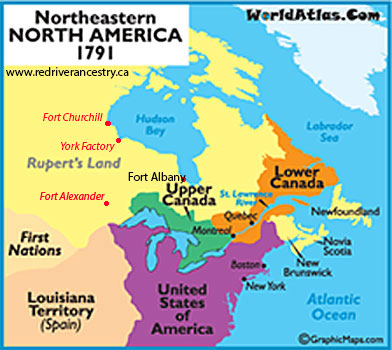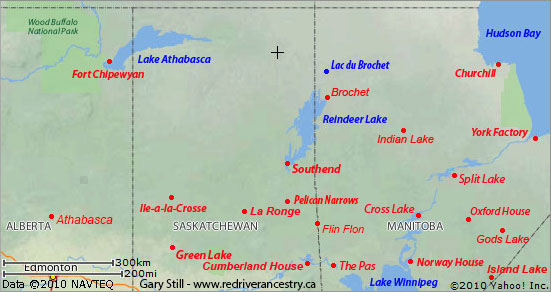JACQUES CHASTELLAIN (c1770-) (Last Updated: August 28, 2012)
Jacques CHASTELLAIN, a French Canadian,was born around 1770 (my rough estimate based upon his activities and the 1795 birth date of son Nicolas). We don’t know much about Jacques’ origins. He was very likely born in Upper or Lower Canada, or perhaps in the Fort William - Grand Portage area at the west end of Lake Superior.
The surname has numerous variations, most commonly CHASTELLAINE, CHATELAIN, or CHATELLAIN.
Upper and Lower Canada were created in 1791
By the 1790’s , the Hudson's Bay Company (HBC) began expansion of its fur trade operations in the far western reaches of the Saskatchewan River, in fierce competition with the North West Company (NWC). In 1793 Peter FIDLER, William FLETT and John WARD explored the shoreline in the Edmonton area on horseback for the HBC looking for a site to build a trading post, but none was built at that time.
During this period, as a young man, Jacques CHASTELLAIN became an employee of the NWC, probably as a voyageur and/or clerk. Typically, in the spring, the Nor’Westers (NWC traders) loaded their canoes with trade-goods in the fall and travelled via the Pigeon and Rainy rivers to Lake of the Woods, down the Winnipeg River to Lake Winnipeg, thence to the far reaches of the great Northwest Territories (Rupert’s Land). They would winter at their remote trading posts to trade for furs, and in the spring make their way back east retracing the same route.
As one company (HBC or NWC) established a fur trading post, the other would counter by building another post in close proximity. In the summer of 1795 the NWC constructed Fort Augustus near the present city of Fort Saskatchewan. History records James HUGHES, John MACDONALD of Garth and about 20 un-named men (here we might reasonably speculate that John ROWLAND and Jacques CHASTELLAINE were perhaps among those ‘un-named’). Soon after, William TOMISON, Peter PRUDEN and a work crew arrived to build Edmonton House “within a musket shot” of Fort Augustus.
John ROWAND (1787-1854) was a NWC recruit at that time and probably knew Jacques well. ROWAND would grow up to be one of the most powerful traders of his generation, and the most prominent figure in the early history of Edmonton.
Forts Augustus and Edmonton were relocated several times over the next number of years, the traders perpetually looking for the most ideal spot to establish themselves permanently.
Jacque marries Josephte PINAUD
It was in the early 1790’s that Nick began a connubial relationship with Josephte PINAUD. The PINAUD families of the Edmonton area were essentially Indians, obviously with some French Canadian ancestral origins in eastern Canada. The PINAUD surname is often mentioned in relation to Indian bands that later became the Papachase Band and the short-lived Stragglers Band (later relocated to Enoch, Hobbemah, Ermineskin, etc). Their first child may have been a daughter named Marie (identified in the Scrip records as a child, but with no birth date).
On one of his return trips to Grand Portage around that time, Jacques brought his pregnant wife with him; son Nicolas was born there around 1795 (his precise birth date is somewhat arbitrary). Around this time Jacques is known to have occupied a NWC house (probably during the winter) near Nipawin, SK.
In 1799 HBC trader James Curtis BIRD (1773-1856) was assigned to Edmonton House where he would become the man in charge of Inland Posts in the Saskatchewan River District for many years to come.
In 1801-02 aboriginal trails through the western territories had not yet been mapped. Siksika head man OLD SWAN, AK KO MOKKI, drew two maps of the western plains for fur trader Peter FIDLER.
Around 1808 Jacques’ family was completed (as we know it) with the birth of son Louis CHASTELLAIN at Cumberland House.
Grand Portage of course was Jacques’ home base, and he would often return there with the fur brigades in the spring and summer. In his teens, eldest son Nicholas accompanied his father on these trips, gaining experience as a voyageur as he reached manhood.
Around 1811 daughter Marie may have married in St Vital (MB) to a French Canadian named Pierre GEORGE. Such a marriage appears in the Scrip records but we cannot be sure if this was Jacques’ daughter.
War of 1812
On June 18, 1812, the Americans stunned the world by declaring war on Great Britain. William McKAY (1772-1832), a retired former Nor’Wester and shareholder, immediately offered his services to the British Army. McKAY would serve under Major General Isaac BROCK (1769-1812), and among his first recruits was Nicholas (Nick) CHASTELLAINE (Jacques’ son) who is said to have led a group of Ojibway warriors in the first event in the War, the Capture of Fort Mackinac on July 17, 1812. That war ended in December of 1814 with the Treaty of Ghent.
Troubles at Red River, a Métis Rebellion
The history books are full of the complexities of the Métis Rebellion, so I will only touch upon a few events of importance.
In 1812 the first settlers recruited by Lord SELKIRK (and supported by the HBC) and led by Governor Miles MACDONELL (1767-1828) began to arrive at Red River. The NWC were strongly opposed to this turn of events. They were about to lay claim to land that the Nor’Westers and French-Métis buffalo hunters and traders considered their rightful domain. When another large group of settlers arrived in 1813, the NWC-HBC rivalry became very bitter indeed. They Nor’Westers were able to prey upon the fact that the settlers were in dire need of food supplies, particularly buffalo meat.
Hoping to discourage the settlers, the Métis and Nor’Westers purposely created a shortage of this commodity by hoarding it away, and in desperation, on Jan 8, 1814, Governor MacDONELL issued his “Pemmican Proclamation”.He followed that up with forcible seizure of NWC supplies. In July that year the NWC held its annual meeting at Fort William where an indignant William McGILLIVRAY (1764-1825) declared regarding MacDONELL’s actions "It is the first time the Nor'Westers have permitted themselves to be insulted". From that day there would be civil war in the North-West. It was in 1815 that Cuthbert GRANT (1796-1854) led a Red River Métis Rebellion (with much encouragement by the Nor’Westers).
Jacques switches allegiance to the HBC
McGILLIVRAY and the Nor’Westers made several attempts to involve Ojibwe Indians of the Fort William area into the affray, but for the most part they were unsuccessful. In this effort the HBC made similar overtures. In 1816, while he was at Fort William, Colin ROBERTSON (1783-1842) convinced Jacques CHASTELLAIN to join the HBC as a Clerk. This must have been in the spring of 1816 (before Mar 17, when ROBERTSON seized the NWC’s Fort Gibraltar, and certainly before June 11, 1816, when ROBERTSON departed for England (via York Factory). On June 19, 1816, Governor Robert SEMPLE (1777-1816) was killed in the Seven Oaks Massacre.
On Aug 12, 1816, Lord SELKIRK and his soldiers arrived at Fort William where he arrested all of the NWC Partners who were present. All of these men were later released.
During the winter of 1816-17 (according to Governor George SIMPSON’s Journal, Jacques was employed at Fort William. Whether or not Jacques had been with ROBERTSON during his troubles at Red River we cannot be sure.
In 1817 William McGILLIVRAY led an expedition that recaptured Fort William for the NWC. That same year, Jacques was sent to the HBC’s Cumberland House. Later he was transferred to the Peace River District.
Sir John FRANKLIN on his Coppermine Expedition
On Aug 23, 1820 Sir John FRANKLIN (1786-1747) leader of the historic Coppermine Expedition (1819-1822) reached Cumberland House on its way to the Arctic Ocean, accompanied by George BACK(1796-1878). Expedition journals recorded that on Sep 26, 1820, they reached Fort Chipewyan in a fleet of 11 canoes led by “CHATELAIN” (Jacques CHASTELLAIN). FRANKLIN continued on from Fort Chip, but Jacques remained at the HBC’S nearby Fort Wedderburn during the winter of 1820-21. Wedderburn was established (in 1815) by the aforementioned John CLARKE, challenging the NWC’s Fort Chipewyan.
To read more about the rest of FRANKLIN’s journey, use this Link: COPPERMINE EXPEDITION. Use the Back < Button to return here. NWC-HBC Union
Upon the NWC-HBC union of 1821 Fort Wedderburn was abandoned in favour of Fort Chip. Jacques would have been around 50 years old in 1821. HBC staff was drastically cut back after the union, with retirements and non-renewal of work contracts. It is said that Jacques retired to Montreal in his latter years, his contract having expired. There is almost nothing more to be found about him in the records or histories after this time, and no record as to when or where he or his wife died.
It was around 1821 that son Nicholas CHASTELLAIN married Nanette CHARTIER, and soon after became a regular HBC employee in the Lac La Pluie District (later named Fort Frances).
In 1838 son Louis CHASTELLAIN married at Norway House to Genevieve SAVOYARD-LAROCQUE.
Please post comments & queries at this link: FORUM DISCUSSING JACQUES CHASTELLAIN & FAMILY
========================== Family Details ==========================
Children: 1. MARIE CHATELAIN (?m. Pierre GEORGE) This might be the Marie CHATLELAIN who married around 1811 in St Vital to Pierre GEORGE 2. c1795 NICOLAS CHATELAIN (m. Nanette CHARTIER) ** MORE ABOUT NICHOLAS CHASTELLAINE Ancestors of Lorna CHASTELLAINE (1910-1988) who married Bill GROVE (1906-1997) of Selkirk, Manitoba Lorna was a daughter of Lydia COCHRANE & JOHN DAVID CHASTELLAINE (1883-1951) 3. 1808 LOUIS CHASTELLAIN (m. Genevieve (Archange) SAVOYARD dit BERTHELET)
========================== Notes & References ==========================
|


